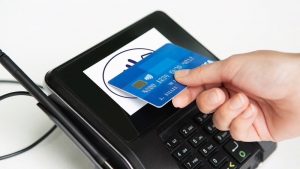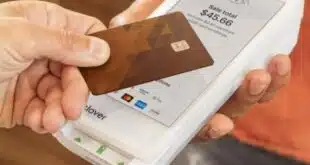It’s another go-around for contactless payments as Visa Inc. prepares an extensive campaign involving issuers, merchants, and consumers to push use of the payment method. The card brand on Tuesday debuted an infographic on contactless payments from across the globe, and touted the preparedness of the U.S. market for the tap-and-go payment method.
Visa says 50% of its face-to-face transactions happened at contactless-enabled merchant locations as of June, meaning the merchant’s point-of-sale equipment was enabled for, not just capable of, conducting a contactless card payment. Unlike mobile payments, in which consumers use smart phones to make tap-and-go payments with digital versions of cards, contactless credit and debit card payments are generally characterized as those made with a plastic card. Visa says 95% of new POS terminals being shipped are contactless-capable. Visa intends to update its public contactless data on a periodic basis. It would not share the U.S. contactless penetration rate.
This is not a new concept. In the mid-2000s the card brands, along with many issuers, promoted contactless payments based on a magnetic-stripe standard, but failed to gain much ground with most consumers and merchants. What’s different today, says Dan Sanford, Visa vice president for consumer products, is that the POS equipment to accept contactless payments is in place.

“Thirteen years ago, we were in the mag-stripe environment, we already had the speed,” Sanford says. “We had clients doing contactless, but we didn’t have nearly the merchant adoption.” Today’s contactless technology uses a wireless EMV standard.
What’s different today is the merchant adoption. Visa says 79% of quick-serve restaurants already are contactless enabled, as are 77% of drug stores and pharmacies and 61% of food and grocery merchants.
Unlike the mid-2000s, the card brands also benefit today from the millions of advertising dollars spent by the mobile-payment services—Apple Pay, Google Pay, Samsung Pay, and a bevy of retailer ones—promoting their tap-and-go payments.
“They’ve done a ton to galvanize and drive acceptance in this country,” Sanford tells Digital Transactions News. Many merchants, valuing the brand recognition attached to companies like Apple, Samsung, and Google, installed the acceptance equipment for the mobile-payments services. That equipment also can accept contactless card payments. Both payment methods share near-field communication technology that enables a short-range, secure data connection.
However, the onset of mobile payments likely motivated many issuers to hold back from issuing contactless cards while they sorted their mobile strategies, Sanford says. It’s almost four years since the most prominent, Apple Pay, debuted. Some issuers may be nearer to providing contactless cards that also have a contact chip. Sanford says Visa is having “lots of conversations with our clients on the rollout and timing. A lot of what we’re doing now is awareness driven. Once you get cards in the market, you’ll see us do campaigns to drive adoption.”
The other change is that the U.S. migration to the EMV standard is largely complete. As of June, 499.7 million Visa credit and debit cards had an EMV chip, accounting for 69% of the network’s U.S. cards.
Cards remain a consumer favorite. “When you look at every market in the world, what’s driving the contactless adoption is the contactless card form factor,” Sanford says. Consumers have used the payment card for more than 60 years, he says.
Visa’s optimism for contactless payments is buoyed by what has happened in similar markets where EMV was introduced and contactless adoption followed. “What we’ve seen, in all of these markets that have contactless, they had this two-step experience,” Sanford says. For example, the United Kingdom began its move to EMV in 2006. Ten years later, 78% of debit cards and 62% of credit cards there were contactless.
A major motivator for Visa, its issuers, other card brands, and their issuers is the opportunity for contactless transactions to displace cash payments. In 2015, cash was used in 32% of all transactions, including bill payments, according to the latest figures available from the Federal Reserve Bank of San Francisco.
In a review of what drove contactless payments in other markets, Visa found that they tended to be for lower-ticket purchases. “Those low-ticket transactions swayed heavily toward cash,” Sanford says. The opportunity to displace cash is strong, especially with the terminal infrastructure in place. In Europe, the average contactless transaction is valued at $15 compared with $56 for a contact EMV payment.
Analyst Thad Peterson at Aite Group says, “It’s entirely possible that contactless will get traction in the U.S. in the next few years,” based on its adoption in the United Kingdom. “NFC penetration is high and merchants are increasingly lighting up the capability,” Peterson says.
A tipping point will be a contactless program announced by a major issuer, he says. “Once a major issuer distributes the cards to a significant population, usage of contactless will become increasingly visible and that may drive consumer demand. It’s up to the issuers to take the step to get the cards out to their cardholders. Once that happens, this might be the moment,” Peterson says.
The effort to move to contactless payments will encompass more than Visa and its issuers, Sanford says. “The industry is going to migrate the U.S. to contactless payments.”




